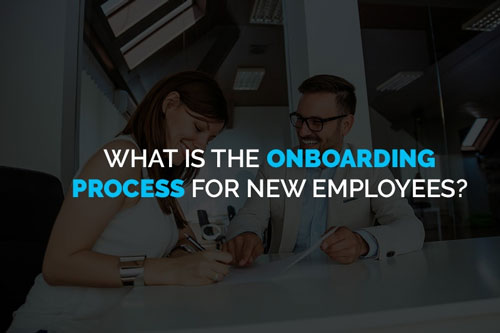After sifting through applications and emails and scheduling interviews or meetings, onboarding a new employee seems like just another hassle to fit into your day. But onboarding is an essential part of a new employee’s assimilation. A solid, sound welcome onto the team is a component of great employee retention. Having a honed and refined process can make things less daunting for you from the beginning, and it can make the process go smoothly for you and the new employee.
What is the Onboarding Process for a New Employee?
Before answering that question, it’s important to answer what onboarding is NOT: orientation. Many employers lump their onboarding process with the orientation process, getting those tax forms and general paperwork filled out on the first day. But this is a waste of time. Keep the paperwork for a time separate from your employee’s first day on the job so you can focus on what onboarding actually IS: introducing the new employee to the routines and behaviors necessary for the job. Onboarding is both a physical and mental tour of the workplace, getting a feel for the environment’s layout and atmosphere.
Onboarding should include every level of staff that the new employee will interact with: team members, supervisors, managers. During the process, it will be helpful to include regular check-ins so the employee knows that his or her coworkers are looking out for them, and managers can determine whether the employee has acclimated properly.
Related: Why Brand Culture Matters in an Organization

Share this Infographic On Your Site (Copy & Paste)
Onboarding Process Steps
Onboarding, unlike orientation, is an extended process that begins even before a new employee has been hired and continues throughout the first month of his or her employment—or longer, depending on the employer and the position.
Before They Arrive
Onboarding begins well before a new employee’s first day, and these are a few tools that will help him or her adjust to the workplace:
- Inform current employees of the new hire. No new employee would like to come in on their first day just to face an office filled with surprised employees who had no idea they were getting a new co-worker. Being in the know will help the staff become more cohesive.
- Set up work space (desk, computer, cabinets). Sharing a computer with another coworker until the IT guy can install a new one will not help with productivity, nor will it be very comfortable for the employees.
- Prepare necessary materials such as ID badges. This will save time on the first day for the new employee to get right into their training rather than waiting at security for their ID to print.
- Grant access to any email accounts or computer software. Similarly, getting this done sooner will allow for extra training time later.
Their First Day
On the first day, new employees get nervous and might be too overwhelmed by the information to ask questions. Be prepared by doing the following things:
- Clarify logistics (where to park, location of restrooms and break room).
- Do a quick tour (if this hasn’t been done prior to the first day such as during the interview) to help your new employee gather his or her bearings on a day that’s stressful enough without having to roam the halls in search of the restroom.
- Make introductions to necessary staff. This will help your new employee feel welcome as well as make sure they know the chain of command and who they should directly report to for various issues and questions.
- Explain expectations of the job. Though this should have been outlined before the first day, reminding your new employee of the company’s brand and objectives will further motivate them to hit the ground running.
- Initial training. Training will occur all throughout the onboarding process, and it starts Day One.
- Provide informational documentation. They’re getting a lot of information at once, so some helpful handouts and guides to reiterate anything you’ve said will help just in case they forget something.
- Get them started! Don’t be afraid to give them a project from the get-go. Be it something small to start or a collaborative assignment, let them know you hired them for a reason—you trust them to get the job done.
The Following 30 Days
The pressure of landing a new job doesn’t end after the first day, so throughout the first month:
- Regularly meet one-on-one. Maybe once or twice a week, a quick meeting to get an update on their progress will keep you aware of what aspects of training need clarification.
- Integrate the new employee with the rest of the team. Throughout onboarding, try some group activities to make your new employee feel comfortable. Something as simple as a team lunch will prompt small talk and hopefully allow the team to bond.
- Hold a performance evaluation at the end of the month. By the end of 30 days, new employees should have a solid understanding of their work. A skills and knowledge evaluation will show you whether or not this is true. If the evaluation isn’t up to standard, you’ll have to determine if the fault is with the onboarding process or the employee.
Related: Interior Design, Branding, and the Influence on Your Culture
New Employee Orientation Best Practices
Of all the actions you can take to make your new employee’s assimilation smooth and painless, the most important tip by far is to make a great first impression. A new employee’s first day sets the tone for his or her future work ethic. A warm welcome and a get-to-know-you lunch can boost morale before it has a chance to waver.
Furthermore, never assume that a new employee will remember every piece of information the first time around. There’s a lot to take in, so prepare for that by providing material guides and remain patient when you repeatedly hear the same questions.
You can also learn how to improve your onboarding process through regular check-ins; these will enlighten you to the strong and weak points of the process while reassuring your new employee that you care about whether he or she is comfortable with the adjustment.
The Importance of Good Onboarding
Onboarding is one of the most important facets of the overall work experience. This is when new employees complete the bulk of their training, so if employees receive halfhearted onboarding, they’re less likely to feel comfortable in their position, and retention rates may decrease. Constantly interviewing and hiring new employees is exhausting, so developing a strong onboarding process will save you future hassle while gifting your business a strong workplace morale.


